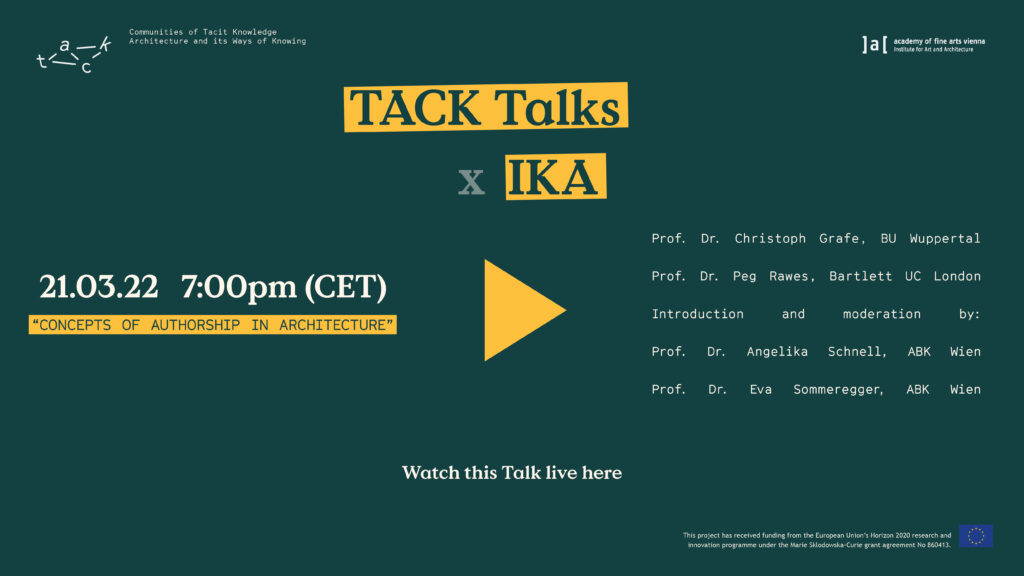Return to archive
title
TACK Talks #3: Architecture and its Tacit Dimensions
guest speakers
Lara Schrijver Tom Avermaete
hosted by
Angelika Schnell Academy of Fine Arts Vienna, Institute for Art and Architecture
The third round of the TACK Talks was hosted by the Institut für Kunst und Architektur (IKA) at the Akademie der Bildenden Kunst Wien (ABKW) and organised as a series of discussions between two or three academic partners of the research project who offered their understanding and vision of the tacit dimensions of architectural knowledge.
The title and theme of the research project, and consequently of the lecture series, derived from the idea of “tacit knowledge”, which was introduced by Michael Polanyi and Gilbert Ryle starting in the 1950s. They addressed the fact that there is a whole range of forms of knowledge that we learn and apply implicitly, mainly through immediate physical implementation, without being able to explain them precisely. For Polanyi, this meant that, “we know more than we can say”. (Riding a bicycle is often cited as an example of “knowing how” rather than “knowing that”.) Architecture, and especially the architectural design process, fits well into this thesis. For although many architects make great efforts to explain and (post-) rationalise their design approaches, the actual process remains unknown, even when working in a team. The physical activity of sketching, drawing, building working models, etc. is individual and collective at the same time, since in addition to the subjective choice of forms and structures, there is also recourse to the familiar, because it is easy to communicate: processes, images and jargon, which in turn also promote habitual prejudices.
It would be easy to say that this implicit knowledge need not become explicit. This attitude has in fact intensified, especially as part of modernist criticism from the 1970s onwards: architecture should be autonomous again, should be art, and should do without rational explanatory patterns. But there are some points that, conversely, should make interest in tacit knowledge grow. First of all, of course, there is the increased use of digitalisation tools in the design process, which promotes rationalisation. If the only physical activity in designing is clicking a mouse, can something like tacit knowledge emerge? And wouldn’t we need it? By whom and how is architecture then explained? This leads to the second point. In times of crisis, construction should critically engage with the public. Enigmatic explanations of beautifully drawn architectural visions are no help. Conversely, an artistic process does not have to be described prosaically. Instead, awareness of and sensitivity to other kinds of knowledge should be communicated in order to be able to promote precisely the creative power of unconventional projects. And furthermore, research into “tacit knowledge” in architecture would at the same time be a contribution to “artistic research” in architecture, a field that is yet obscure and needs to be explored in greater detail, which task the ten doctoral students involved in the research project took on in particular.
Held at the Institut für Kunst und Architektur, Akademie der Bildenden Kunst Wien, this is the initiating event in the 3rd round of TACK talks: Communities of Tacit Knowledge: Architecture and its Ways of Knowing
“Architecture and its Tacit Dimensions” is a lecture given by two of the supervising professors in the network: Prof. Dr. Lara Schrijver, University Antwerp and Prof. Dr. Tom Avermaete, ETH Zurich.
Prof. Dr. Lara Schrijver, University Antwerp
Much of architecture’s knowledge resides beneath the surface, in non-verbal instruments such as drawings and models that articulate the spatial imagination of the design process. Tacit knowledge, described by Michael Polanyi as what we “can know but cannot tell”, today often denotes knowledge that escapes quantifiable dimensions of research. Through a number of historical examples, this talk shows how architecture’s tacit knowledge can help to understand the many dimensions of the spaces we inhabit, from the ideas of the architect to the more hidden assumptions of our cultures.
Prof. Dr. Tom Avermaete, ETH Zurich
In the field of architecture several ‘epistemes’ are constantly at work, but often without being explicitly discussed or critically scrutinized. These tacit forms of knowledge not only inform but also determine the way that architects observe their environment and the way they intervene in it. This talk will address the presence of this ‘black box’ of epistemes within architectural culture and illustrate how it informs a new domain of architectural research.




